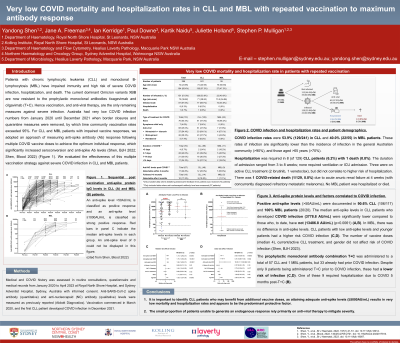Category: General Abstract
1132 - Very low COVID mortality and hospitalization rates in CLL and MBL with repeated vaccination to maximum antibody response

Introduction
Patients with chronic lymphocytic leukemia (CLL) and monoclonal B-lymphocytosis (MBL) have impaired immunity and high risk of severe COVID infection, hospitalization, and death. The current dominant Omicron variants XBB are now resistant to the prophylactic monoclonal antibodies tixagevimab and cilgavimab (T+C). Hence vaccination, and anti-viral therapy, are the only remaining measures against severe infection. Australia had very low COVID infection numbers from January 2020 until December 2021 when border closures and quarantine measures were removed, by which time community vaccination rates exceeded 95%. For CLL and MBL patients with impaired vaccine responses, we adopted an approach of measuring anti-spike antibody (Ab) response using multiple COVID vaccine doses to achieve the optimum individual response, which significantly increased seroconversion and anti-spike Ab levels (Shen, BJH 2022; Shen, Blood 2022). We evaluated the effectiveness of this multiple vaccination strategy against severe COVID infection in CLL and MBL patients.
Methods
Medical and COVID history was assessed in routine consultations, questionnaire and medical records from January 2020 to April 2023 at Royal North Shore Hospital, and Sydney Adventist Hospital, Sydney, Australia with informed consent. Anti-SARS-CoV-2 spike antibody (quantitative) and anti-nucleocapsid (NC) antibody (qualitative) levels were measured as previously reported (Abbott Diagnostics). Vaccination commenced in March 2020, and the first CLL patient developed COVID infection in December 2021.
Results
In this study, there were 296 patients with CLL (241) and MBL (55) with up to 8 (median 4) vaccine doses included. COVID infection rates were 53.9% (129/241) in CLL and 40.0% (22/55) in MBL patients. 7 CLL patients had a second episode of infection. These rates of infection are significantly lower than the incidence of infection in the general Australian community (>90%), and those aged >65 years (>70%).
Hospitalization was required in 8 (of 129) CLL patients (6.2%) with 1 death (0.8%) from beginning of the pandemic in January 2020 until April 2023. The duration of admission ranged from 3 to 8 weeks; none required ventilation or ICU admission. Three were on active CLL treatment (2 ibrutinib, 1 venetoclax), but did not correlate to higher risk of hospitalization. There was 1 COVID-related death (1/129, 0.8%) due to acute anuric renal failure at 4 weeks (with concurrently diagnosed refractory metastatic melanoma). No MBL patient was hospitalised or died.
There were 61 (of 129, 47.3%) CLL patients treated with anti-viral therapy; 33 received nirmatrelvir + ritonavir (54.1%), 23 molnupiravir (37.7%), and 5 remdesivir (8.2%). Of the 8 hospitalized CLL patients, 5 received remdesivir only, 1 molnupiravir and 2 no anti-viral therapy. Of the total 23 COVID infected MBL patients, 15 (68.2%) received no medication and 7 (31.8%) received antiviral therapy; 4 nirmatrelvir + ritonavir (57.1%) and 3 molnupiravir (43.9%).
Positive anti-spike levels (>50AU/mL) were documented in 90.6% CLL (106/117) and 100% MBL patients (20/20). The median anti-spike levels in CLL patients who developed COVID infection (3778.8 AU/mL) were significantly lower compared to those who, to date, have not (13486.8 AU/mL) (p=0.0061) (Figure 1A and 1B). In MBL, there was no difference in anti-spike levels. CLL patients with low anti-spike levels and younger patients had a higher risk COVID infection (Figure 1C and 1D).
Anti-nucleocapsid antibody (anti-NC Ab) post-COVID infection were detected in 12 of 48 CLL (25.0%) and 5 of 9 MBL (55.6%) within 2 months. Among patients followed >6 months, only 9 of 12 CLL patients (18.8% of 48) and 1 of 5 MBL patients (11.1% of 9) still had detectable anti-NC antibodies (Table 1). Hence, anti-NC Ab is not a reliable marker of COVID infection in CLL populations.
Despite only 9 patients being administered T+C prior to COVID infection, these had a lower risk of infection (Figure 1C and 1D); 1 required hospitalization due to COVID 5 months after T+C (Figure 1B). The currently dominant Omicron XBB variants (NSW respiratory surveillance reports 2023), are now resistant to prophylactic T+C highlighting that the optimum stimulation of endogenous immune response remain very important.
Conclusion
CLL and MBL patients have impaired immune response to vaccination, leading to slower and lower levels of anti-spike response. A multiple vaccine doses strategy to optimal response resulted in very low mortality (0.8%) and hospitalization rates (6.2%).
Patients with chronic lymphocytic leukemia (CLL) and monoclonal B-lymphocytosis (MBL) have impaired immunity and high risk of severe COVID infection, hospitalization, and death. The current dominant Omicron variants XBB are now resistant to the prophylactic monoclonal antibodies tixagevimab and cilgavimab (T+C). Hence vaccination, and anti-viral therapy, are the only remaining measures against severe infection. Australia had very low COVID infection numbers from January 2020 until December 2021 when border closures and quarantine measures were removed, by which time community vaccination rates exceeded 95%. For CLL and MBL patients with impaired vaccine responses, we adopted an approach of measuring anti-spike antibody (Ab) response using multiple COVID vaccine doses to achieve the optimum individual response, which significantly increased seroconversion and anti-spike Ab levels (Shen, BJH 2022; Shen, Blood 2022). We evaluated the effectiveness of this multiple vaccination strategy against severe COVID infection in CLL and MBL patients.
Methods
Medical and COVID history was assessed in routine consultations, questionnaire and medical records from January 2020 to April 2023 at Royal North Shore Hospital, and Sydney Adventist Hospital, Sydney, Australia with informed consent. Anti-SARS-CoV-2 spike antibody (quantitative) and anti-nucleocapsid (NC) antibody (qualitative) levels were measured as previously reported (Abbott Diagnostics). Vaccination commenced in March 2020, and the first CLL patient developed COVID infection in December 2021.
Results
In this study, there were 296 patients with CLL (241) and MBL (55) with up to 8 (median 4) vaccine doses included. COVID infection rates were 53.9% (129/241) in CLL and 40.0% (22/55) in MBL patients. 7 CLL patients had a second episode of infection. These rates of infection are significantly lower than the incidence of infection in the general Australian community (>90%), and those aged >65 years (>70%).
Hospitalization was required in 8 (of 129) CLL patients (6.2%) with 1 death (0.8%) from beginning of the pandemic in January 2020 until April 2023. The duration of admission ranged from 3 to 8 weeks; none required ventilation or ICU admission. Three were on active CLL treatment (2 ibrutinib, 1 venetoclax), but did not correlate to higher risk of hospitalization. There was 1 COVID-related death (1/129, 0.8%) due to acute anuric renal failure at 4 weeks (with concurrently diagnosed refractory metastatic melanoma). No MBL patient was hospitalised or died.
There were 61 (of 129, 47.3%) CLL patients treated with anti-viral therapy; 33 received nirmatrelvir + ritonavir (54.1%), 23 molnupiravir (37.7%), and 5 remdesivir (8.2%). Of the 8 hospitalized CLL patients, 5 received remdesivir only, 1 molnupiravir and 2 no anti-viral therapy. Of the total 23 COVID infected MBL patients, 15 (68.2%) received no medication and 7 (31.8%) received antiviral therapy; 4 nirmatrelvir + ritonavir (57.1%) and 3 molnupiravir (43.9%).
Positive anti-spike levels (>50AU/mL) were documented in 90.6% CLL (106/117) and 100% MBL patients (20/20). The median anti-spike levels in CLL patients who developed COVID infection (3778.8 AU/mL) were significantly lower compared to those who, to date, have not (13486.8 AU/mL) (p=0.0061) (Figure 1A and 1B). In MBL, there was no difference in anti-spike levels. CLL patients with low anti-spike levels and younger patients had a higher risk COVID infection (Figure 1C and 1D).
Anti-nucleocapsid antibody (anti-NC Ab) post-COVID infection were detected in 12 of 48 CLL (25.0%) and 5 of 9 MBL (55.6%) within 2 months. Among patients followed >6 months, only 9 of 12 CLL patients (18.8% of 48) and 1 of 5 MBL patients (11.1% of 9) still had detectable anti-NC antibodies (Table 1). Hence, anti-NC Ab is not a reliable marker of COVID infection in CLL populations.
Despite only 9 patients being administered T+C prior to COVID infection, these had a lower risk of infection (Figure 1C and 1D); 1 required hospitalization due to COVID 5 months after T+C (Figure 1B). The currently dominant Omicron XBB variants (NSW respiratory surveillance reports 2023), are now resistant to prophylactic T+C highlighting that the optimum stimulation of endogenous immune response remain very important.
Conclusion
CLL and MBL patients have impaired immune response to vaccination, leading to slower and lower levels of anti-spike response. A multiple vaccine doses strategy to optimal response resulted in very low mortality (0.8%) and hospitalization rates (6.2%).
- SM
Stephen Mulligan, MBBS, PhD
Consultant haematologist
Royal North Shore Hospital
Sydney, Australia - YS
Yandong Shen, PhD
CLL research fellow
Royal North Shore Hospital, New South Wales, Australia - JF
- IK
- PD
- KN
- Jh

